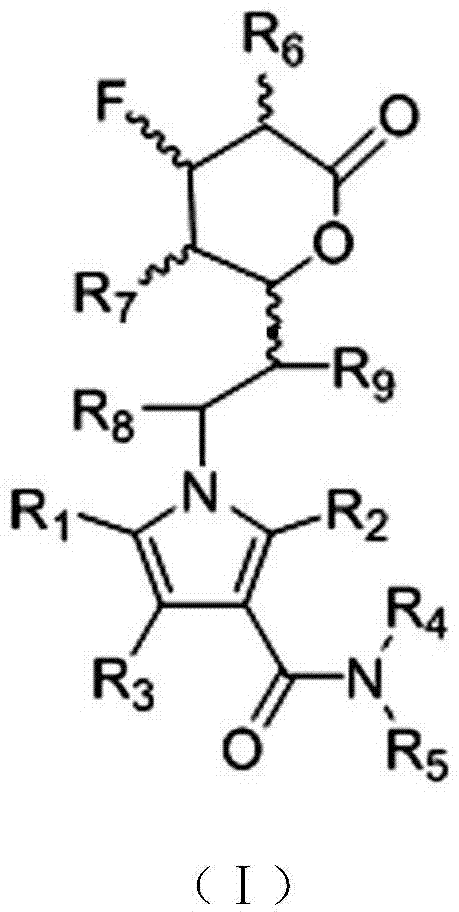Multi-substituted pyrrole statin fluorine-containing derivatives and uses thereof
A drug and oxo-generation technology, which is applied in the field of statin derivatives and multi-substituted pyrrole statins containing fluorine modification, can solve the problems of side effects, liver disease, carcinogenic toxicity, etc.
- Summary
- Abstract
- Description
- Claims
- Application Information
AI Technical Summary
Problems solved by technology
Method used
Image
Examples
Embodiment 1
[0115] Example 1 Preparation of Atorvastatin Lactone
[0116] Weigh 5.00g of atorvastatin calcium salt, add it to a 250ml eggplant-shaped bottle, add 100ml of dichloromethane and about 10ml of 20-fold diluted hydrochloric acid, acidify, separate, and extract three times with 100ml of dichloromethane , the lower organic phases were combined and dried over anhydrous sodium sulfate. Concentrate and evacuate with an oil pump to obtain 4.54 g of white powder, namely the crude product of atorvastatin carboxylic acid.
[0117] Weigh 4.00 of the crude product of atorvastatin carboxylic acid above, add it into a three-necked flask, add 0.05 g of p-dimethylaminopyridine, 50 ml of dichloromethane and a stirring bar. A solution obtained by dissolving 5.0 g of dicyclohexylcarbodiimide in 20 ml of dichloromethane was slowly injected under ice cooling. After the dropwise addition, the ice bath was removed and the reaction was carried out overnight at room temperature. After the completion...
Embodiment 2
[0118] Example 2 Preparation of Compound 001
[0119] Add a magnetic stirring bar of appropriate size into a 50ml reaction tube, replace the air and protect it with nitrogen, inject 30ml of dichloromethane, put the reaction vessel into a low-temperature stirring reaction bath (below -65°C), and inject 0.75ml of Diethylaminosulfur trifluoride, after stirring for about 15 minutes, slowly added 1.50 g of atorvastatin lactone dissolved in 5 ml of dichloromethane. After stirring and reacting for about 30 minutes, about 0.3 ml of triethylamine was added by injection, and after 2 hours, the temperature was naturally raised to react overnight. After the completion of the reaction was monitored by thin-layer chromatography, it was suction-filtered, and the filtrate was dried over anhydrous sodium sulfate, spin-dried, and separated by column chromatography (PE / EA gradient elution) to obtain 0.76 g of atorvastatin fluorinated product (001).
Embodiment 3
[0120] Example 3 Preparation of Compounds 002 and 003
[0121]Take 1.00 g of atorvastatin fluoride (001), dissolve it in 6 ml of tetrahydrofuran, and put it in an ice bath, add 1.5 ml of 1 mol / L LiOH solution and stir for 2 hours, then acidify it with 10% hydrochloric acid until the pH is 2-3, then reduce Evaporate the solvent at 45°C, add about 10ml of acetone to dissolve, and slowly add 10% Na 2 CO 3 Aqueous solution, flocs and turbidity can be seen, add dropwise until flocs no longer appear. Heat until the turbidity dissolves, let it stand, and cool down slowly overnight. On the next day, 0.57 g of flocculent crystals, ie atorvastatin fluoride sodium salt (002), was obtained.
[0122] Take 1.00 g of atorvastatin fluoride (001), dissolve it in 6 ml of tetrahydrofuran, and put it in an ice bath, add 1.5 ml of 1 mol / L LiOH solution and stir for 2 hours, then acidify it with 10% hydrochloric acid until the pH is 7-8, then reduce Evaporate the solvent at 45°C, add about 10ml...
PUM
 Login to View More
Login to View More Abstract
Description
Claims
Application Information
 Login to View More
Login to View More - R&D
- Intellectual Property
- Life Sciences
- Materials
- Tech Scout
- Unparalleled Data Quality
- Higher Quality Content
- 60% Fewer Hallucinations
Browse by: Latest US Patents, China's latest patents, Technical Efficacy Thesaurus, Application Domain, Technology Topic, Popular Technical Reports.
© 2025 PatSnap. All rights reserved.Legal|Privacy policy|Modern Slavery Act Transparency Statement|Sitemap|About US| Contact US: help@patsnap.com



